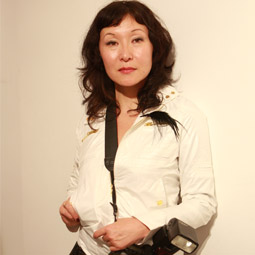Almagul Menlibayeva, famous contemporary artist from Kazakhstan, whose artwork focuses on the history and cultures of Central Asia, will be taking part in one of the oldest and most significant international contemporary art events of the year, the Venice Biennale.
The Venice Biennale, the major contemporary art exhibition with its 120-year-old history, incredible range of artworks makes an important cultural impact and offers a rare and valuable experience in contemporary art. This year the 56th Venice Biennale is titled All the World’s Futures and will take place between May 9 and Nov. 22.
“The ruptures that surround and abound around every corner of the global landscape today recall the evanescent debris of previous catastrophes piled at the feet of the angel of history in Angelus Novus. How can the current disquiet of our time be properly grasped, made comprehensible, examined, and articulated? Over the course of the last two centuries, the radical changes have made new and fascinating ideas subject matter for artists, writers, filmmakers, performers, composers, musicians. It is with this recognition that the 56th International Exhibition of la Biennale di Venezia proposes All the World’s Futures, a project devoted to a fresh appraisal of the relationship of art and artists to the current state of things,” said Exhibition Curator Okwui Enwezor, explaining the main concept behind this year’s biennale.
Menlibayeva will be one of the distinguished artists exhibiting their works in Venice. The artist recently sat down with The Astana Times to discuss her work.
What will you be displaying at the exhibition?
The project I am working on is called, “The Union of Fire and Water.” Suad Garayeva, curator of the YaratContemporaryArt Organisation based in Baku, Azerbaijan, has invited me to co-author the project together withanother Azerbaijani artist Rashad Alakbarov. Our project explores the points of contact between the histories of the two great cities: Baku and Venice. In the early 20th century, then the world’s largest oil producer, Baku flourished and experienced a building boom. The architects of the city were largely inspired by the Venetian Gothic style, turning some parts of Baku strikingly resemblant of the famous Italian floating city. For the upcoming biennale I am making an 11-channel video installation, which I titled, “Fire Speaks to Me,” and Rashad is building a very modern and complex sculptural installation.
Why “Fire Speaks to Me?”
Baku and the cusp of the Caspian Sea have been viewed as the land of fire in the folklore starting from the sacred teachings of Zoroastrianism to the modern descriptions deriving from ever-growing oil industry. For me, this concept has a sacred significance. Fire denotes and brings transformation. The title was also inspired by an outstanding historical figure, Azerbaijani oil tycoon, Murtuza Mukhtarov, whose fascinating personality and life story really speak to me.
What is the significance of the upcoming biennale for you?
I have set an artistic goal, which is mastering the video art through the use of different techniques to narrate history through the prism of contemporary art. More precisely, my work will allow the viewer to follow a story line from the videos simultaneously shown on different screens and in different rooms. Thus, the video-editing is the real challenge here, since they will need to be precise on every split second. And of course, the place where the biennale will be held, its architecture and history are distinct.
As an artist, what inspires you?
I am inspired by people, work process, travel and history. For me, art is a dialogue mediated by visual images. Verbal communication can be limited at times. I find great enjoyment in giving this visual communication the new forms. That’s why, I do not adhere to just one art technique; I believe art exists beyond any technique. Dialogue is the measurement of my art work.



